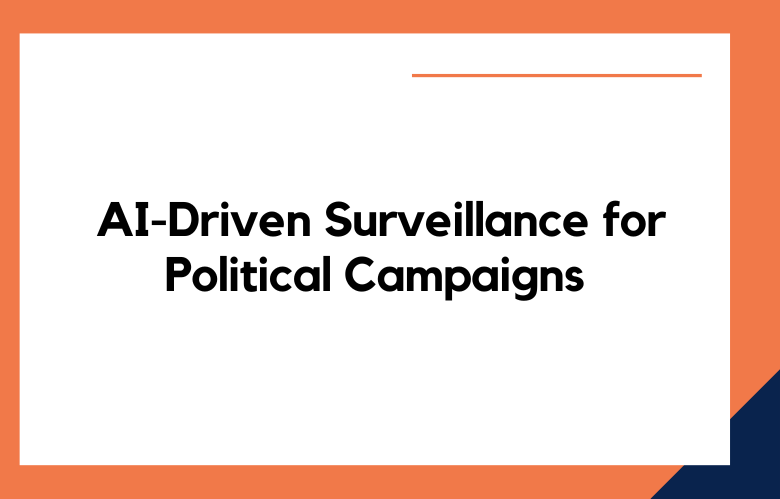AI-driven surveillance in political campaigns involves the application of AI algorithms to collect, analyze, and interpret data about voters and their behavior. This data can include everything from social media activity and online search patterns to purchasing habits and demographics.
AI-driven surveillance aims to give campaigns a deeper understanding of voter preferences and behavior, enabling them to tailor their messaging and outreach efforts for maximum impact.
AI-Driven Surveillance for Political Campaigns
Data Collection: AI algorithms can collect data from various sources, including social media platforms like Twitter and Facebook, search engines like Google and Bing, and other online sources like news websites and blogs. The data collected can include information on voters’ political preferences, interests, and behaviors, as well as their demographic characteristics and online activity.
Analysis and Interpretation: AI algorithms can analyze the collected data to identify patterns and trends, providing insights into voter preferences and behavior. For example, AI algorithms can analyze social media activity to identify the most important issues to voters or analyze search patterns to understand the information that voters seek.
Targeted Outreach:
AI-driven surveillance enables campaigns to target their messaging and outreach efforts to specific groups of voters based on their preferences and behaviors. For example, a campaign might target voters who have expressed interest in a particular issue on social media with messaging and outreach efforts focused on that issue.
What is the AI-Driven Surveillance for Political Campaigns?
AI-driven surveillance uses artificial intelligence (AI) to gather and analyze voter behavior and preferences data, aiming to inform political campaign strategies. This technology has the potential to revolutionize the way campaigns operate, enabling them to make more informed decisions and optimize their outreach efforts.
At its core, AI-driven surveillance involves using AI algorithms to analyze vast data on voter behavior, including social media activity, online search patterns, and purchasing habits. By analyzing this data, campaigns can gain valuable insights into voter preferences and behavior, allowing them to tailor their messaging and outreach strategies to specific demographics.
For example, AI-driven surveillance can help campaigns identify voters most likely to respond positively to a particular message or policy proposal, enabling them to focus their efforts on those most likely to support their candidate. Similarly, AI-driven surveillance can help campaigns identify voters who may be on the fence, allowing them to tailor their messaging to address their concerns and persuade them to support their candidate.
AI-driven surveillance is a powerful tool for political campaigns to understand voters better and optimize their outreach efforts. By harnessing the power of AI, campaigns can make more informed decisions, reach more voters, and ultimately drive more successful outcomes.
How to Use AI-Driven Surveillance for Political Campaigns
AI-driven surveillance in political campaigns has become increasingly prevalent as campaigns seek to gain an edge in a highly competitive landscape. From tracking voter sentiment to monitoring social media trends, AI surveillance can provide valuable insights into the electorate and help campaigns shape their messaging and strategies. However, using AI surveillance raises critical ethical questions about privacy, transparency, and accountability.
This guide will explore the opportunities and challenges of using AI-driven surveillance in political campaigns. We will discuss the benefits of AI surveillance, such as its ability to provide real-time insights and targeted messaging. We will also examine the potential risks, including privacy violations, algorithmic biases, and public mistrust.
We will provide practical tips for using AI surveillance responsibly and ethically for political campaigns. This includes establishing clear policies and guidelines, prioritizing transparency, and engaging with stakeholders.
By implementing effective oversight measures and prioritizing the ethical use of AI surveillance, political campaigns can harness the power of AI while promoting fairness and transparency in the political process.
Revolutionizing Political Campaigns: Harnessing the Power of AI-Driven Surveillance
Political campaigns are in a constant state of evolution as new technologies emerge and reshape the landscape. Artificial intelligence (AI) is a technology transforming how campaigns are run, providing unprecedented insights into voter behavior and allowing campaigns to tailor their messaging and strategies accordingly.
Among the various AI-driven tools available, AI-driven surveillance has emerged as a powerful tool, enabling campaigns to track voter sentiment, monitor social media trends, and gain a competitive edge.
This guide will explore how AI-driven surveillance is revolutionizing political campaigns. We will discuss how AI surveillance provides real-time insights into voter behavior, enabling campaigns to adapt their strategies and stay ahead of the curve. We will also examine how AI surveillance can enhance voter engagement, allowing campaigns to connect with voters more personally and build stronger relationships.
The Secret Weapon: Implementing AI-Driven Surveillance in Political Strategies
Implementing AI-driven surveillance in political strategies is controversial and ethically fraught. While AI technology can benefit some regions of political campaigning, its use in surveillance raises significant concerns related to privacy, civil liberties, and democratic principles. Here are some key considerations and potential risks associated with this approach:
Privacy Invasion
The use of AI-driven surveillance in political strategies can infringe upon the privacy of individuals. Citizens may feel uncomfortable or violated when their actions, communications, or behaviors are monitored without consent.
Surveillance State Concerns
Extensive surveillance can create a state where the government or political campaigns have excessive control over citizens’ lives, potentially suppressing dissent and inhibiting free speech.
Chilling Effect
The knowledge that one is under constant surveillance may deter individuals from engaging in political activities, attending rallies, or expressing their opinions freely, leading to a chilling effect on democracy.
Targeting and Profiling
AI-driven surveillance can enable the profiling and targeting of individuals based on their political beliefs, affiliations, or behaviors. This can lead to discrimination, harassment, or marginalization of certain groups.
Misuse of Data
There’s a risk that collected data can be misused or fall into the wrong hands, leading to unintended consequences or potential abuse of power.
Lack of Transparency
Implementing AI-driven surveillance without transparency can erode public trust. Citizens have a right to know when, why, and how their data is collected and used for political purposes.
Ethical Concerns
The ethical implications of using surveillance technology in politics are significant. Ethical guidelines and oversight mechanisms must be in place to ensure responsible use.
Legal and Regulatory Issues
There are often legal and regulatory hurdles to overcome when implementing surveillance technology, especially when collecting and processing personal data. Failure to comply with these laws can result in legal consequences.
Potential for Abuse
AI-driven surveillance systems can be prone to misuse by those in power, whether it’s a political campaign, government agency, or any other entity. Safeguards against abuse must be robust.
Maximizing Efficiency: Integrating AI-Driven Surveillance into Political Campaigns
Political campaigns always seek ways to maximize efficiency and gain a competitive edge. With the rise of AI-driven surveillance, campaigns now have access to powerful tools that can help them optimize their strategies and stay ahead of the competition.
By integrating AI-driven surveillance into their campaigns, political teams can leverage data and insights to enhance their messaging, target their outreach, and gain valuable insights into the electorate.
This article will explore the benefits of using AI-driven surveillance in political campaigns and provide practical tips for integrating this technology into campaign strategies.
We will discuss how AI-driven surveillance can help campaigns optimize their messaging, target their outreach, and stay ahead of the competition. We will also examine the potential challenges and risks associated with AI-driven surveillance and guide how to mitigate these risks.
Unleashing AI’s Potential: Surveillance in the Hands of Political Campaigns
Integrating AI-driven surveillance into political campaigns can revolutionize how campaigns operate, providing unprecedented insights into voter behavior and enabling campaigns to make data-driven decisions. By harnessing the power of AI surveillance, political campaigns can unleash the potential of AI to gain a better understanding of voters, tailor messaging to specific demographics, and stay ahead of the competition.
This article will explore how political campaigns use AI surveillance to enhance operations and drive successful outcomes. We will examine the various tools and technologies available for AI-driven surveillance, including social media monitoring, sentiment analysis, and predictive modeling. We will also discuss the importance of ethical considerations in using AI surveillance, including privacy concerns, algorithmic biases, and potential abuse.
The Rise of AI-Driven Surveillance: A Game-Changer for Political Campaigns
Political campaigns have always been high-stakes; every move can mean the difference between winning and losing. In recent years, AI-driven surveillance has dramatically changed the landscape of political campaigning, giving campaigns unprecedented access to information about voters and enabling them to tailor their messaging in real time.
This article will delve into the game-changing potential of AI-driven surveillance for political campaigns, exploring how it allows campaigns to understand their target audience better, optimize their outreach strategies, and stay one step ahead of their competitors. We will also examine the potential pitfalls of AI-driven surveillance, such as privacy concerns and the potential for misuse, and provide tips for navigating these challenges.
Conclusion
The use of AI-driven surveillance in political campaigns offers both opportunities and challenges. While AI surveillance can provide valuable insights and enhance campaigning strategies, it also poses risks to privacy, transparency, and public trust.
Political campaigns must prioritize the ethical use of AI surveillance by establishing clear policies, promoting transparency, and engaging with stakeholders. By embracing AI surveillance responsibly, political campaigns can leverage the power of AI to enhance their campaigning strategies while upholding democratic values and safeguarding public trust.
As the political landscape evolves, political campaigns must stay abreast of the latest developments in AI-driven surveillance and adapt their oversight measures accordingly. By prioritizing AI surveillance’s ethical and responsible use, political campaigns can leverage this powerful technology to engage with voters meaningfully and effectively while promoting fair and transparent elections.
Call: +91 9848321284
Email: [email protected]











